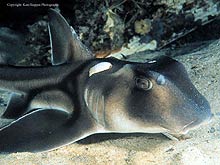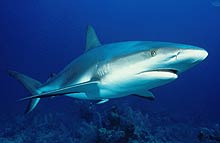Interview with a shark scientist
Stirling Peverell, Shark Researcher
Queensland Department of Primary Industries and Fisheries.
1. How long have you worked at your current place of employment?
Since graduating from university in 1997.
2. Have you always been a shark biologist?
No. I was previously working on finfish. In particular the barramundi stocks in the Queensland Gulf of Carpentaria. My primary role was a fisheries observer working with commercial gill net fishermen.
As an observer I recorded biological and catch information for barramundi and king salmon as well as documenting different technical aspects of the fishing operation such as fishing method, location description (habitat), and fishing effort.
|

Juvenile freshwater sawfish, note
the numerous rostrum teeth.
Image © Stirling Peverell
|
3. How did you become a shark biologist?
4. Why did you become a shark biologist?
One of the key responsibilities as a fisheries observer is to identify with issues of concern within the fishery. Shark is identified as a bycatch in the Gulf of Carpentaria barramundi fishery and a lack of knowledge on their biology and life history as well as how many were being taken was of concern. There has been a general consensus within the scientific community that global shark populations have been severely threatened due to over fishing, a thought I would not like to witness here in Australia. It was these concerns that prompted me to focus on shark research and direct my interest away from finfish. By undertaking research on shark I can also help the remote fishing communities of the Gulf of Carpentaria, By understanding how old a shark lives for, how many pups it can produce, how often it reproduces, the size it reaches maturity and its preferred habitat, we can better manage the fishery by suggesting to the fishermen how many shark they should be able to take and during what time of the year. This will protect the fishermen’s long term income by ensuring there are enough sharks around to continue to fish.
5. What shark/s do you work with?
I work on approximately 15 different shark species, mostly whaler shark species and sawfish. Sawfish possess an extended rostrum or bill, which is marked with numerous pointed teeth (see photo above). You have to be extremely careful when handling these animals. Aboriginals use to cut the bills off sawfish to use as weapons when fighting or hunting.
6. What are you trying to find out about the sharks?
We are trying to find out the life history and biology of these animals and how they interact with our commercial, recreational and indigenous fisheries.
The critical information is how many are we killing and whether their population can handle such pressure.
|

Whaler shark
Image © |
9. Have you ever been diving in a shark cage?
No. However, I would love to dive with the great white sharks off South Australia one day.
10a. What's the best part about your job?
The best part of my job is working outdoors and visiting some interesting and fantastic places. I have fished all of the rivers in the Gulf of Carpentaria something people would normally pay tens of thousands of dollars for the same privilege.
10b. Worst part?
Fishing during the cyclone season. I have sat through three cyclones whilst working as a fisheries observer and on all three occasions got violently seasick. The other worst part is coming home after a shark observer trip and my wife telling me I smell.

|
